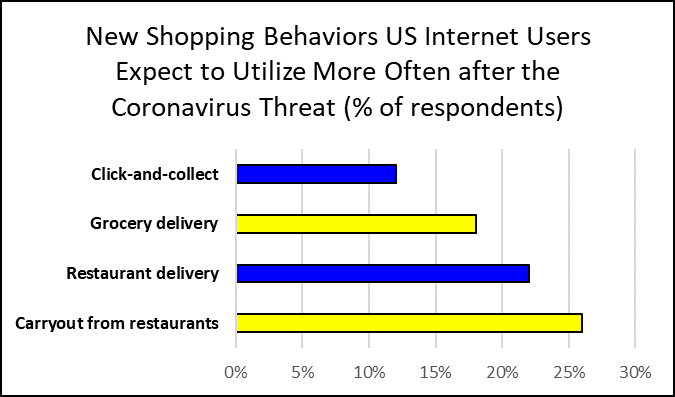COVID-19 Impact Report: QSR
As one of the few essential businesses allowed to remain open in most states, restaurants are pivoting to address the COVID-19 pandemic head on. QSR’s and restaurants alike have faced tough questions over the past several weeks: How will they sustain with take-out/delivery alone? Should they market to consumers? How can they meet demand while scaling back? What will the post COVID-19 future hold & will their businesses survive?
During this pandemic fast food has proven to be efficient, inexpensive and a necessity for many consumers that are unable to get to the grocery store. Locations with drive-thru lanes, delivery services, and take-out order functions have been allowed, and in some cases encouraged, to stay open by state and city officials. With limited options available, QSR chains are still capable of providing much needed services for the nation while in quarantine.
Despite being able to remain open, the restaurant industry has taken one of the hardest hits. Due to stay at home orders, consumers can no longer enter physical (dine-in) locations leading to thousands of restaurant closures across the U.S. Current estimates based on research provided by the National Restaurant Association conclude that one in five restaurants across America could permanently close due to the coronavirus outbreak. In the last month, the restaurant industry has lost over 3 million jobs.[1] In an effort to draw in consumers who normally receive takeout elsewhere, many surviving dine-in restaurants are adapting by making the conscious shift to take-out/delivery.
While QSR chains are well positioned with online ordering and delivery, in many cases they need to connect efficiently to remain a top choice for consumers who are spending less and being more selective about their restaurant choices.[2] Quick-serve loyalists are limiting where they will purchase food from as they visit their “favorite” spots more frequently than before. When it comes to acquisition, consumers are looking for incentives to sway their QSR ordering decisions. For many brands, in-app delivery updates and opt-in preferences, such as text messages, allow QSR’s a unique opportunity to build their brand with customers directly. Bottle Rocket found that 80 percent of customers were more likely to order from a restaurant if they offer rewards for digital or text message ordering.[3] This unique situation has signified the importance of ensuring a positive customer experience. QSR’s are tasked with building a new kind of awareness with their user base instead of eliciting a transactional response, while prioritizing customer health above all else.
Chipotle is hosting virtual lunch hangouts with celebrity guests and other exclusive content. Starbucks is moving toward a to-go model nationwide. Cracker Barrel is offering contactless delivery for all orders more than $15. Jersey Mike’s is offering free delivery for mobile orders. McDonald’s and Burger King are encouraging consumers to utilize drive-thru options. Similarly, Domino’s and Papa John’s have emphasized delivery orders.[4] The examples given highlight effective methods for showing users how QSR locations have adapted to social distancing rules, engaged users, and transitioned them to utilize online functions such as contact-free delivery and curb side pickup/drive thru.
In addition to adapting for consumer acquisition and retention, many QSR’s are finding ways to eliminate excess internal costs as a way to alleviate the financial burdens they face. Many menus have been updated to reflect the following: narrowed/limited menu offerings, added price discounts, coupons, meal deals, family/bulk size options and full bundle meals.
Looking to the future, restaurants must focus on positioning themselves for success in the post-COVID-19 era. More than 60 percent of restaurant operators are preparing for a 3–6 month hit in the food service industry.[5] With cautioning against reopening markets too quickly, it is expected that the timeline of openings will differ across state lines. It is also likely that many other brands will look to retain and build their new delivery models adopted during the pandemic. Several restaurants will work on improving their take-out/delivery packaging to make better at-home experiences for customers. There will also undoubtedly be fewer new restaurant openings. Openings will most likely continue to stall as restaurateurs focus on recovering from any losses suffered during the pandemic.
An eMarketer report found that many consumers plan to continue utilizing carryout from restaurants post COVID-19.[6] The figure below illustrates additional long-term effects we expect to see with consumers once quarantine comes to an end.

Delivery models will continue to thrive as lingering heightened health concerns make it a valuable option for the new customer experience post-pandemic. As a result, we expect to see a significant amount of investments navigating towards take-out and delivery services in the months to come. Consumers will have a “cleanliness comes first mentality” when it comes to dining out. Sanitation and good hygienic practices will be at the forefront of deciding where they want to dine. When asked about how consumers will feel once social distancing comes to an end, a Dataessential survey found 76 percent of respondents believe that a restaurants’ cleanliness and food safety will matter more to them.[7]
As restaurants look to reopen, experts say they will need to take additional steps to ensure safety. These might include reducing capacity, having employees wear masks, and capping how long diners can stay there.[8] Implementing these protective measures alongside complimentary messaging, can help prepare for a successful re-opening. Ultimately, QSR brands that focus on building a brand with an innovative, flexible and hygienic approach to a better customer experience, will have the most long-term success.
[1] https://www.businessinsider.com/coronavirus-is-going-to-change-restaurants-for-years-2020-4#customer-temperature-checks-could-be-the-norm-2
[2] https://www.qsrweb.com/blogs/3-branding-experts-weigh-in-on-qsr-bond-building-mid-pandemic/
[3] https://www.qsrmagazine.com/consumer-trends/how-customers-are-interacting-fast-food-covid-19-era
[4] https://www.adweek.com/brand-marketing/4-ways-fast-casual-restaurants-can-build-their-brand-while-still-being-social-distancing-compliant/
[5] https://www.qsrmagazine.com/consumer-trends/covid-19s-impact-perspective-restaurant-owners
[6] https://chart-na2.emarketer.com/235313/new-shopping-behaviors-us-internet-users-expect-utilize-more-often-after-coronavirus-threat-march-2020-of-respondents?li=1
[7] https://www.qsrmagazine.com/consumer-trends/when-covid-19-ends-heres-how-restaurants-will-win
[8] https://www.businessinsider.com/air-conditioning-spread-coronavirus-restaurant-can-service-industry-open-again-2020-4
